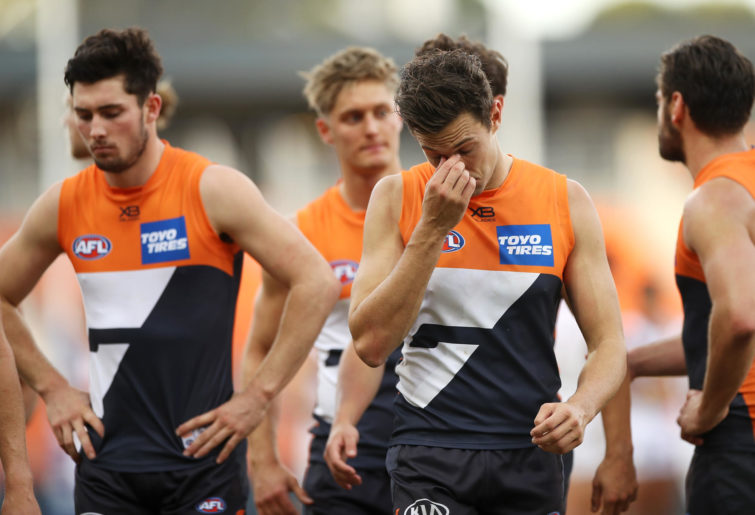The pecking order is effectively a ladder of the manner in which the teams that played in the round of AFL performed, therefore it’s not purely based on results.
Round 10 proved to be a difficult round to rank the teams as there were more close games than one-sided games. There were four games out of seven games that were played with a margin of 13 points or less. St Kilda were picked first on the pecking order for the second round in a row, because they could have beaten any other team based on the way in which they played in Round 10.
Gold Coast were second on the pecking order, even though they lost to St Kilda as they couldn’t have done much more. The only thing missing was the win. Gold Coast would have beaten any other team in the pecking order based on their Round 10 performance.
At the other end of the spectrum the Adelaide Crows performed in a manner where they could have lost to any other team in the AFL based on their Round 9 performance.
In Round 10 there was only 14 teams to rank as four teams had the bye: Carlton, Fremantle, Hawthorn and West Coast. This made it an intriguing exercise to analyse all 14 teams that played.
1. St Kilda played as a team and showed great endeavour. They controlled the tempo of the game early. They clearly missed Jarryn Geary’s leadership, as Geary was a late withdrawal. It wasn’t due to St Kilda not performing well in the second quarter, but Gold Coast’s intense attack on the footy. In the third quarter the intensity went up and so did the efficiency of St Kilda’s ball use, especially inside 50. St Kilda did brilliantly to win the game as they had a two-goal deficit in the fourth quarter, but they won the game by four points, through sheer will and playing an impeccable brand of footy.
2. Gold Coast stayed in the contest as they played a good brand of footy. Their appetite to the contest was good. They forced their way back into the game in the second quarter with brilliant execution in the forward 50. Their intensity was extremely high in the second quarter, which set the scene for a great game of footy. They managed to stay in the contest on the scoreboard in the third quarter although St Kilda controlled the balance of play. They scored 74 points in the game – the third highest of any losing team in AFL season 2020.
3. Richmond didn’t bring the intensity they normally have to the contest. They fought back from a two-goal deficit early in the contest. They kicked the next three goals of the first quarter, which meant that they were in front on the scoreboard at quarter time. After that the game was a forgone conclusion, with Richmond showing that they are potential contenders.

(Photo by Robert Cianflone/Getty Images)
4. Geelong brought a high amount of intensity to the game in the first quarter in their Round 10 clash with North Melbourne. Geelong definitely weren’t taking North Melbourne lightly. The speed at which the footy was moved by Geelong was impressive, but they wasted their opportunities to kick goals in the second quarter. Their kicking kept North Melbourne in the game. That was until the third quarter where Geelong took their chances. Geelong had too much class and polish for North Melbourne, but Geelong would be disappointed that they didn’t win by more than 33 points as they had 25 scoring shots to North Melbourne’s 12.
5. Port Adelaide started the game off slowly. They made uncharacteristic errors and weren’t performing to their usual level. Port Adelaide were outplayed in the first half, but they managed to stay in the game on the scoreboard. In the third quarter they punished the Western Bulldogs on the scoreboard for not taking their chances in the first half. Port Adelaide took their opportunities. They sit on top of the AFL ladder because they have taken their chances.
6. Collingwood didn’t have a good system early in the piece. They weren’t accurate with their goal kicking in the early stages of the game. They kicked just six points from 16 inside 50s in the first quarter, with the scores level at six points each at quarter time. Trey Ruscoe kicked his first AFL goal. That was also their first goal of the game. That was one of only two goals for them in the first half. They did suffer three injuries, but that’s no excuse for their inaccurate kicking for goal. They had 20 shots on goal to the Sydney Swans’ 11, but Collingwood only won by nine points.
7. Greater Western Sydney kept Essendon in the game as Greater Western Sydney played safe footy in the first quarter. Their ball use was slow as they didn’t look like they wanted to take risks. It appeared as if they weren’t prepared for the pressure that Essendon applied. It was disappointing to watch Greater Western Sydney play as their performance wasn’t up to standard in the second quarter.

(Photo by Mark Kolbe/Getty Images)
Greater Western Sydney lifted their intensity in the second half and showed their class by coming back and winning the game by four points, as they kicked six goals to Essendon’s two after halftime. Whatever Leon Cameron said to the players at halftime worked.
8. The Western Bulldogs brought a high intensity to the contest, but they failed transfer that control onto the scoreboard. They controlled the balance of play at times, as they had a superior brand of footy to that of Port Adelaide. The Western Bulldogs showed a greater amount of endeavour than Port Adelaide in the first half. The Western Bulldogs were completely outplayed in the third quarter and suffered on the scoreboard because of it. It was sad to watch a team that has so much potential lose a game they could have won. They had 17 shots on goal to Port Adelaide’s 15, but Port Adelaide were more clinical.
9. The Brisbane Lions played a superior brand of footy to Richmond in Round 10 at times. They managed to kick the opening two goals in the game. They were outplayed for a fair chunk of the remainder of the first half. Although Brisbane controlled certain stats, they couldn’t hit the scoreboard. Cam Rayner being injured had an impact on their performance. Brisbane Lions were their own worst enemies, kicking four goals and 17 behinds. They had just one less scoring shot than Richmond, but Brisbane’s final score was half of Richmond’s, which was 82 points to 41 points.
10. The Melbourne Demons brought a higher level of intensity than they did in Round 9 from the opening bounce. The scoreboard indicated that they needed to show more endeavour, as they led by just four points at quarter time, but no disrespect to the Adelaide Crows, they weren’t as strong an opposition as the Brisbane Lions were in the Melbourne Demons’ Round 9 capitulation. They only led by five points at halftime and 12 points at three quarter time. Their last quarter would have pleased the Melbourne Demons as they annihilated the hapless Adelaide Crows on the scoreboard, winning by an impressive 51 points.
11. North Melbourne played average footy early in the game. They were unfortunate to lose Ben Brown early, due to a knee injury, which impacted their system and structure. Despite that, they benefited from the youthful exuberance of debutant Lachlan Hosie, who kicked two goals in the first quarter. They didn’t attack much in the second quarter, as they failed to kick a goal. In the third quarter they managed to kick a couple of goals in a row to stay in touch with Geelong on the scoreboard. North Melbourne didn’t appear as if they had as talented a team as Geelong and that was reflected on the scoreboard, which is often an accurate depiction, as North Melbourne lost by 33 points.

(Photo by Darrian Traynor/Getty Images)
12. The Sydney Swans brought a lot of intensity early in the game and were rewarded with the opening goal of the game. They defended manfully, keeping Collingwood goalless in the first quarter, partly through their endeavour, but mainly due to Collingwood’s bad kicking. The Sydney Swans appeared prepared for the Collingwood game style. For example, Darcy Moore normally takes intercept marks. Unfortunately, the Sydney Swans didn’t take enough risks with their ball movement. They were outplayed for the four quarters, but only lost by nine points.
13. Essendon neutralised Greater Western Sydney in the first quarter as they played a brand of footy that kept them in the contest on the scoreboard. Essendon were without Jacob Townsend early on due to concussion, which had an impact on their rotations. There were no goals scored by either team in the first quarter. In the second quarter it was a different kettle of fish, with Essendon dominating the game. They were deplorable in the second half. Essendon kicked six goals in the second quarter and two goals in the other three quarters.
14. The Adelaide Crows were down one player on the bench due to Will Hamill suffering concussion. They were kept in the contest thanks to matching the Melbourne Demons for endeavour and attack at the footy. Despite the fact that the Adelaide Crows were outplayed, their endeavour never wavered until the last quarter, where they appeared to be despondent, at least if you base their fourth-quarter display on the scoreboard, which was extremely embarrassing.































































































